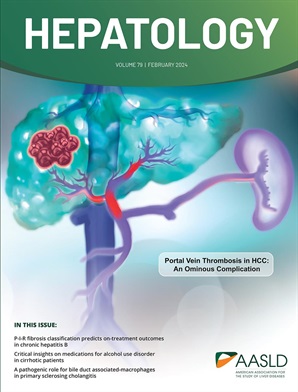AI-based phenotyping of hepatic fiber morphology to inform molecular alterations in metabolic dysfunction-associated steatotic liver disease
IF 12.9
1区 医学
Q1 GASTROENTEROLOGY & HEPATOLOGY
引用次数: 0
Abstract
Background & Aims: Hepatic fiber morphology may significantly enhance our understanding of molecular alterations in metabolic dysfunction-associated steatotic liver disease (MASLD). We aimed to comprehensively characterize hepatic fiber morphological phenotypes in MASLD and their associated molecular alterations using multi-layer omics analyses. Approach & Results: To quantify the morphological phenotypes of hepatic fibers, the artificial intelligence-based FibroNest algorithm (PharmaNest) was applied to 94 MASLD-affected liver biopsies, among which 12 (13%) had concurrent hepatocellular carcinoma (HCC). FibroNest identified 327 fiber phenotypes that were summarized into eight major principal components, named FibroPC1–8. Next, molecular alterations captured by morphological fiber phenotypes were evaluated by comparison with genome-wide transcriptomics of paired liver samples. Pathway analyses revealed that FibroPCs more sensitively captured MASLD-related molecular alterations, such as upregulation of interleukin-6 and susceptibility to resmetirom, compared with the histological fibrosis stage. Among them, FibroPC4, which reflects reticular fibers, was associated with a gene signature predictive of incident HCC from MASLD. Furthermore, we used a spatial single-cell transcriptome, CosMx, to reveal the cell-cell interactions driving MASLD pathogenesis, as captured by FibroPC4. CosMx revealed that the FibroPC4-rich microenvironment contains HCC-promoting hepatic stellate cells (HSCs) located adjacent to periportal endothelial cells (ECs). Neighboring cell analyses suggested that the HCC-promoting phenotype of HSCs was acquired by insulin growth factor-binding protein 7 (IGFBP-7) secreted from senescent periportal ECs. Consistently,基于人工智能的肝纤维形态学表型,为代谢功能障碍相关脂肪变性肝病的分子改变提供信息
背景,目的:肝纤维形态可能显著增强我们对代谢功能障碍相关脂肪变性肝病(MASLD)分子改变的理解。我们旨在利用多层组学分析全面表征MASLD的肝纤维形态表型及其相关的分子改变。的方法,结果:为了量化肝纤维的形态表型,应用基于人工智能的FibroNest算法(PharmaNest)对94例masld影响的肝活检进行了分析,其中12例(13%)合并肝细胞癌(HCC)。FibroNest鉴定出327种纤维表型,并将其归纳为8个主要成分,命名为FibroPC1-8。接下来,通过与成对肝脏样本的全基因组转录组学比较,对形态学纤维表型捕获的分子改变进行评估。通路分析显示,与组织学纤维化阶段相比,FibroPCs更敏感地捕获masld相关的分子改变,如白细胞介素-6的上调和对resmetirom的易感性。其中,反映网状纤维的FibroPC4与预测MASLD发生HCC的基因标记相关。此外,我们使用空间单细胞转录组CosMx来揭示驱动MASLD发病机制的细胞-细胞相互作用,如FibroPC4所捕获的。CosMx显示,富含纤维pc4的微环境中含有位于门静脉周围内皮细胞(ECs)附近的促进hcc的肝星状细胞(HSCs)。邻近细胞分析表明,促hcc表型是由衰老门静脉周围内皮细胞分泌的胰岛素生长因子结合蛋白7 (IGFBP-7)获得的。与此一致的是,体外实验表明IGFBP-7将造血干细胞转化为促进hcc的表型。结论:肝脏形态纤维表型可以揭示MASLD的疾病进展和潜在机制。
本文章由计算机程序翻译,如有差异,请以英文原文为准。
求助全文
约1分钟内获得全文
求助全文
来源期刊

Hepatology
医学-胃肠肝病学
CiteScore
27.50
自引率
3.70%
发文量
609
审稿时长
1 months
期刊介绍:
HEPATOLOGY is recognized as the leading publication in the field of liver disease. It features original, peer-reviewed articles covering various aspects of liver structure, function, and disease. The journal's distinguished Editorial Board carefully selects the best articles each month, focusing on topics including immunology, chronic hepatitis, viral hepatitis, cirrhosis, genetic and metabolic liver diseases, liver cancer, and drug metabolism.
 求助内容:
求助内容: 应助结果提醒方式:
应助结果提醒方式:


